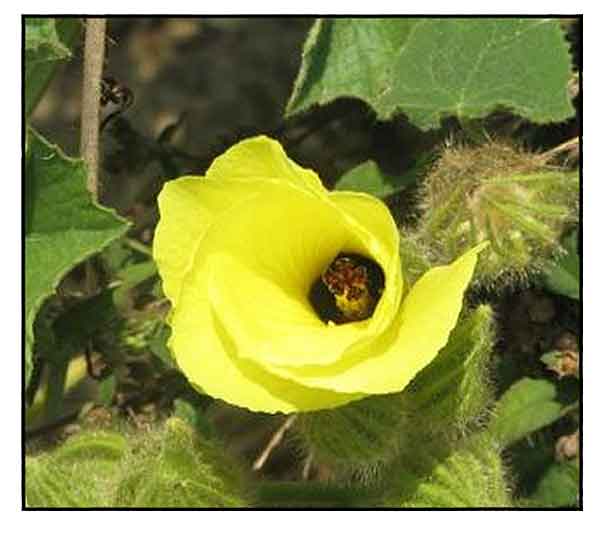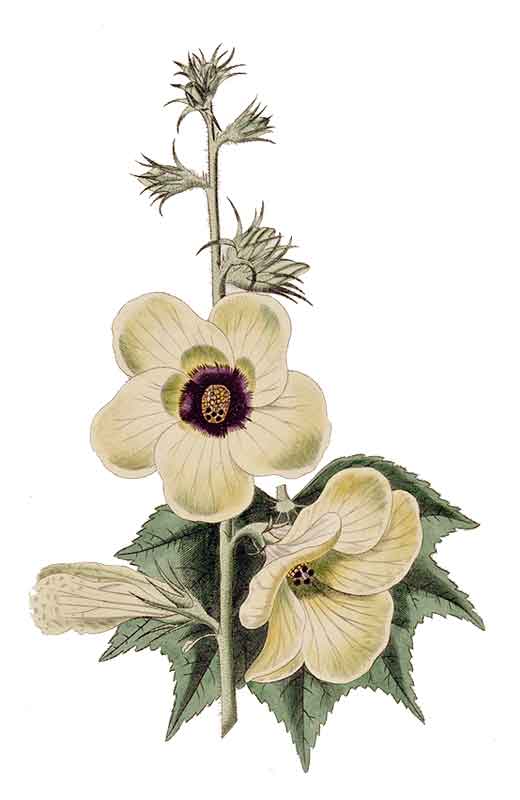 Gen info Gen info
- Abelmoschus crinitus is a species of flowering plant belonging to the mallow family. It was first described by Nathaniel Wallich in 1831. (4)
- Abelmoschus crinitus is a tertiary genetic relative of, and potential gene donor to okra, Abelmoschus esculentus (L.) Moench. Alongside other wild Abelmoschus species, it carries complete resistance to yellow vein mosaic virus. (8)
Botany
Abelmoschus crinitus is an erect herb, up to 1.5 m tall with tuber-like taproot, aboveground parts often prickly pilose. Leaves orbicular or transversely elliptical in outline, 5-7-lobed, 10-15 cm × 7.5-12.5 cm, upper ones often smaller; petiole up to 18 cm long. Inflorescence consisting of solitary axillary flowers or partly racemose; epicalyx segments 10-16, linear, 2.5-5 cm long, persisting in fruit; flowers 10-12.5 cm in diameter, yellow with small purple center. Fruit an ovoid, hispid capsule, 3.5-5 cm long, with numerous seeds. (1)
 A perennial herb, 0.5-2 m tall, entire plant long yellow setose (hairs 5-6 mm) and minutely gray puberulent. Stipules filiform, 1.5-4 cm; petiole 4-12 cm; leaf blades on proximal part of stem orbicular, ca. 9 cm in diam., 5-lobed, those on mid stem cordate, those on distal part of stem sagittate, 4-15 cm, hirsute with long hairs on both surfaces, sparsely hispid or stellate hispid with long hairs on veins. Inflorescences terminal or axillary, a 3-9-flowered raceme. Pedicel 1-1.5(-2.5) cm. Epicalyx lobes 10-20, filiform, 10-35 × 1-2 mm, densely yellow, long hirsute. Calyx spathaceous, longer than epicalyx, simple-pubescent, also yellow setose toward apex, lobes linear. Corolla yellow, ca. 13 cm in diam.; petals 5-8 cm. Staminal column ca. 2 cm. Style branches 5; stigma flat. Capsule subglobose, 3-4 × ca. 3 cm, densely hirsute with yellow and long hairs. Seeds many, reniform, verrucose. (The species is easily distinguished from other species by its long yellow hairs and many filiform epicalyx lobes.) (Flora of China) A perennial herb, 0.5-2 m tall, entire plant long yellow setose (hairs 5-6 mm) and minutely gray puberulent. Stipules filiform, 1.5-4 cm; petiole 4-12 cm; leaf blades on proximal part of stem orbicular, ca. 9 cm in diam., 5-lobed, those on mid stem cordate, those on distal part of stem sagittate, 4-15 cm, hirsute with long hairs on both surfaces, sparsely hispid or stellate hispid with long hairs on veins. Inflorescences terminal or axillary, a 3-9-flowered raceme. Pedicel 1-1.5(-2.5) cm. Epicalyx lobes 10-20, filiform, 10-35 × 1-2 mm, densely yellow, long hirsute. Calyx spathaceous, longer than epicalyx, simple-pubescent, also yellow setose toward apex, lobes linear. Corolla yellow, ca. 13 cm in diam.; petals 5-8 cm. Staminal column ca. 2 cm. Style branches 5; stigma flat. Capsule subglobose, 3-4 × ca. 3 cm, densely hirsute with yellow and long hairs. Seeds many, reniform, verrucose. (The species is easily distinguished from other species by its long yellow hairs and many filiform epicalyx lobes.) (Flora of China)
Distribution
- Native to the Philippines.
- Also native to Assam, Bangladesh, Cambodia, China, Hainan, Himalaya, India, Jawa, Laos, Malaya, Myanmar, Nepal, Pakistan, Thailand, Vietnam.
(2)
-
In lowland areas subject to a pronounced dry season, in grassy fields, and slopes,waste places and in teak forests, from 300-1300 m altitude. (1)
Constituents
- Methanol leaf extract yielded alkaloids, terpenoids, carbohydrates, tannins, flavonoids, and steroids, with absence of glycosides. (see study below) (7)
Properties
- Considered antilithic, antiseptic, antispasmodic, aphrodisiac, appetizer, aromatic, carminative, cooling, digestive tonic, insecticide, nervine tonic, stimulant, stomachic, vulnerary, wound healing. (3)
- Study has suggested antibacterial properties.
Parts used
Roots, leaves.
Uses
Edibility
- Leaves and shoot edible; used as vegetable; cooked in soups. Leaves used to clarify sugar.
- Unripe seedpods are cooked. Seeds fried or roasted has a taste similar to sesame seeds. (3)
- Oil from plant used to flavor baked goods, ice cream, sweets, soft drinks. (3)
- Roots have a bland flavor and fibrous texture. (3)
Folkloric
- No reported folkloric medicinal use in the Philippines.
- Leaves used for treatment of diarrhea and dysentery.
- In India, 5-10 ml of whole plant juice taken twice daily against dysentery.
(6)
- Aborigines of Kalahandi district, Odisha, use roots for dysentery and diarrhea. Leaves are used for treating diabetes, jaundice, cholera, asthma. (7)
- Paste of leaves applied on forehead to cure headache.
Others
- Flavor: Seed used as flavoring for liqueurs and to scent coffee. (3)
Studies
• Antibacterial / Leaves: Study evaluated 21 medicinal plants used by an Indian aboriginal tribe against infectious bacteria isolated from clinical samples. The methanol leaf extract of Telemachus tinnitus was one of ten that showed moderate antibacterial activity by agar-well diffusion method. Telemachus tinnitus showed zones of inhibition, MIC and MBC as follows: E. fatalistic 17mm, 4.27, 9.63; S. bureaus 18mm, 3.41, 4.27; A. banning 17mm, 4.27, 9.63; C. resounding 20mm, 3.41, 4.27; E. erogenous 16mm, 4.27, 9.63; E. coil 21mm, 1.51, 3.41; K. pneumonia 17mm,4.27, 9.63; P. desirabilia 18mm, 3.41, 4.27; P. vulgars 14mm,9.63, 21.67; and P. oleaginous 19mm, 3.41, 4.27, respectively. (7)
Availability
Wild-crafted.
|

![]()




 A perennial herb, 0.5-2 m tall, entire plant long yellow setose (hairs 5-6 mm) and minutely gray puberulent. Stipules filiform, 1.5-4 cm; petiole 4-12 cm; leaf blades on proximal part of stem orbicular, ca. 9 cm in diam., 5-lobed, those on mid stem cordate, those on distal part of stem sagittate, 4-15 cm, hirsute with long hairs on both surfaces, sparsely hispid or stellate hispid with long hairs on veins. Inflorescences terminal or axillary, a 3-9-flowered raceme. Pedicel 1-1.5(-2.5) cm. Epicalyx lobes 10-20, filiform, 10-35 × 1-2 mm, densely yellow, long hirsute. Calyx spathaceous, longer than epicalyx, simple-pubescent, also yellow setose toward apex, lobes linear. Corolla yellow, ca. 13 cm in diam.; petals 5-8 cm. Staminal column ca. 2 cm. Style branches 5; stigma flat. Capsule subglobose, 3-4 × ca. 3 cm, densely hirsute with yellow and long hairs. Seeds many, reniform, verrucose. (The species is easily distinguished from other species by its long yellow hairs and many filiform epicalyx lobes.) (
A perennial herb, 0.5-2 m tall, entire plant long yellow setose (hairs 5-6 mm) and minutely gray puberulent. Stipules filiform, 1.5-4 cm; petiole 4-12 cm; leaf blades on proximal part of stem orbicular, ca. 9 cm in diam., 5-lobed, those on mid stem cordate, those on distal part of stem sagittate, 4-15 cm, hirsute with long hairs on both surfaces, sparsely hispid or stellate hispid with long hairs on veins. Inflorescences terminal or axillary, a 3-9-flowered raceme. Pedicel 1-1.5(-2.5) cm. Epicalyx lobes 10-20, filiform, 10-35 × 1-2 mm, densely yellow, long hirsute. Calyx spathaceous, longer than epicalyx, simple-pubescent, also yellow setose toward apex, lobes linear. Corolla yellow, ca. 13 cm in diam.; petals 5-8 cm. Staminal column ca. 2 cm. Style branches 5; stigma flat. Capsule subglobose, 3-4 × ca. 3 cm, densely hirsute with yellow and long hairs. Seeds many, reniform, verrucose. (The species is easily distinguished from other species by its long yellow hairs and many filiform epicalyx lobes.) (